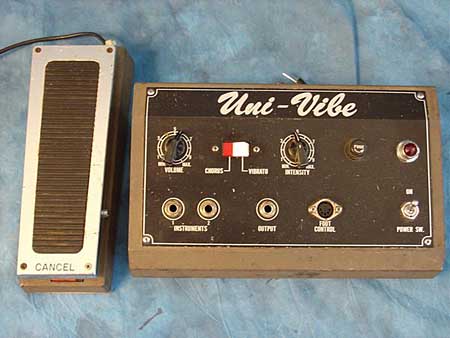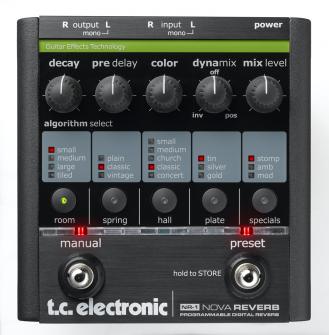Category Modulation Effects
Modulation effects create a secondary signal modulating the input signal. The way as every pedal modulates the signal depends on the effect itself.
Family Phasers
Phasers are copying the original signal and, rotating its phase, across several de-phasing stages and, finally blending original signal with dephased signal or providing just the dephased signal (100% wet effect).
As a result of that cycle of phase rotation, some frequencies are reinforced, while others are being practically cancelled so, despite of the washing sound hear, volume can go up (reinforcement) or down (cancellation), depending on the source note and cycle spot.
The most famous phase pedal effect of all the times is the MXR Phase 90. The Electro-Harmonix Small Stone was also very appreciated and, has an slightly different implementation that results in some different sound.
Some phasers (specially vintage ones) have just one knob to set up the phaser's character, while others provide a higher number of knobs to set up different phasing characteristics as: Phase (effect width), depth (blending dry/wet), speed (sweep speed or lenght of the cycle), etc.
Chorus, Flangers and Vibes are all based on phaser effect but, with some differences.
Family Chorus
Chorus effect is doubling the original signal and, the second signal is being modulated in several ways. As in the Phaser's, the signal has an slight change of phase but not so noticiable as in phasers. Also, the second signal is slightly detuned, to create the sensation that a second instrument is making the chorus to the first instrument.
From the very beginning, Chorus had more controls available than original phasers, even that the control are more or less the same seen in phasers, what changes is the range of speeds that the chorus pedal has (speeder), compared to a Phaser and, that detuning feature.
Well, one of the widely used chorus had just a single control knob: the MXR Micro Chorus but, the epitome of those pedals seems to be the Boss CE-1 (Chorus Enssemble 1), that provided warm and lush chorus tones.
Family Flanger
Also based on Phaser effect, the flanger work in a different speed range (slower) so, the sweeping of a flanger is slower than in a Phaser. Additonaly to this, the flanger includes a regeneration stage, that gets the output of the flangered signal, feeding back the input signal (that has now the original guitar signal plus the already flangered signal).
Flanger is the hardest sounding effect of this family and creates that Jet-alike type of sweep.
I was hardly ussed by Eddie Van Hallen but, it's also present in many records and many different instruments (I can remember the flanged batery bridge change in 'No Quarter' by Led Zeppelin, by example).
One of the most famous flangers was the MXR M-117 but not the unique mythical unit around.
Family Tremolo
The Tremolo effect is affecting the loudness of the signal during a cycle. It drops the signal every X time in a cycle, resulting in a trembling sound.
When Leo Fender built his first Vibrato-loaded amps, he failed naming the effect, the vibrato channels of well known Fender's amps is really a Tremolo effect. Nowadays, it is difficult to change that wrong naming.
To make things even more confussing, Leo Fender gave the name Tremolo arm to the floating bridge's arm used in Stratocasters. The whammy arm of a floating bridge is just a Vibrato effect and, not a tremolo effect but, imagine, who can fix this error!.
Some of the first Tremolo pedal effects were also named Vibratos so, be sure what do you have on hands.
Family Vibrato
The vibrato, instead of changing the loudness of the signal is affecting slightly the frequency, shifting a bit the pitch up and down during a certain cycle. Results are quite similar but, not exactly the same as with a tremolo.
The whammy bar of a floating bridge is the most understable vibrato effect. By moving down or up the bar, you are pitching down or up the sustained note. A vibrato pedal does this permanently and at regular periods.
Read Tremolo's description to be aware of the confussion between Tremolo and Vibrato effects.
Let say that the chorus is a mix of vibrato and phaser, with modified speed range.
Family Vibes
The vibe is an special take of the chorus effect, and its between a phaser, a chorus and a vibrato pedal in-a-box. Even having some common ground with all them, it has a very distinctive sound, very similar to the effect that a Leslie rotating speaker delivered in Organs.
Many other Rotating Speaker effects are quite similar to the vibe effect.
The sweep of the vibe seems to be deeper than the sweep of a phaser, creating the sensation that the sound rotates 360º around your head.
This amazing effect is the basis of "Machine Gun" by Hendrix (a true master on the use of this pedal effect).
The most famous vibe effect of all the times is the Dunlop Univibe, even that current edition doesn't seems to be so accurated to the original one, as Boutique's pedal designers claim.
Family Talk Box
This is a really interesting pedal and, maybe the most human one, since we can modulate the sound of our guitar' signal just with our mouth!.
The Talk Box has two inputs: the guitar input and our mouth input. The signal coming from our mouth modulates or sculpts the guitar' signal, producing really interesting sounds.
To achieve this, a tube exits from the Talk Box unit that should be inserted in our mouth (usually, supported with a Mic' stand). The sounds we produce in our mouth are send down the tube to the vox, where a membrane, working like any mic, transduces the air changes into electrical signals. That electrical signals will be used to modify the guitar' signal, producing interesting effects.
First time I clearly heard that effect was in "Show me the way" by Peter Frampton but, of course, that effects' wizzard called Gilmour used it for some Pink Floyd songs (as Dogs from The Wall, by example).
The drawback is that, usually, a Talk Box isn't an chained effect but, the output usually needs to be routed to a separated amp. I think that just the Banshee Talk Box allows you to stack this effect in your chain (but memory can fail here). Just be sure to check how your Talk Box should be connected in your rig before buying one, maybe you cannot have to amps working at same time.
Category Time Effects
Time effects are copying the input signal and creating several images of that signal delayed in time and, decreassing in loudness.
Family Reverb
Reverberation effect tries to emulate the echos obtained in a reflexive room. Depending on the place you are playing, the room can sound very dry and the amp can sound very in your face. Reberberation effect allows to move an step backwards the sound of the guitar and helps to place it within the mix space.
First reverberation effects applied to guitar world was the spring-reverberation. The signal was driven to a can that had several springs, the mechanical movement of those springs was transduced to electric signals and the result blended with the original signal. This is the typical guitar's amp reverberation that we can see in a bunch of amps.
Reverberation echoes are a bit confussing and the first echos produces sub-echoes that, produce sub-sub-echoes, etc.
But nowadays, any versatile reverberation effect includes a wide toolset of different reverberations: Hall (open spaces), Room (small rooms), Cathedral (Cathedral behaviour), Slapback (just a quick echo), etc.
What does new versatile reverberation effects want is to mime the reflexion patterns that some specific spaces have. Some do it in a very good way, some sound very digital.
One of the best reverb effects are found in TC Electronics stuff, that had a lot of experience designing reverb units for Studio Environment.
Family Delay
Delay pedals are quite similar to Reverb pedals but, instead to try to emulate the reflexive patters of some loved spaces, the delay generates just echoes of the input signal, with a certain cadence and with a certain decay time.
Delays are based in the first Echo Units, as the EchoPlex, that used a magnetic tape to record the sound and then, to reproduce the recorded sound slightly after in time.
First Echo or Delay units that had a good use for the regular guitarist were all Boss pedals (like the DD-3).
First delay units were analog and, therefore, their hability to delay the sound in time was very limited.
When digital units came, the delay time went longer.
Analog delay units have a warmer and lusher sound but, they can sound dark, also and, they are not so good for everything, because they can create some kind of veil on your sound.
Digital delay units sound clearer, brighter and more defined but, the drawback is that they can create sound's artiffacts (well known as digititis) that can sound mettalic and synthetic, when overdone.
Maxon AD-999 or the MXR Carbon Copy are two good examples of analog delays, while the well known Boss DD-3 and DD-7 are clear examples of Digital Delays.
Most of modern delay units, despite of having several delay emulations (tape delay, among modeling some delay units used in Studio), can have a looper feature, that allows us to record a short riff and make the unit to repeat it while we continue playing over the riff.










No comments:
Post a Comment
Please, feel free to add your comments.